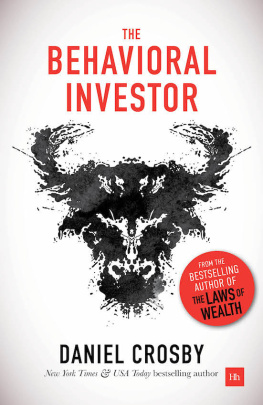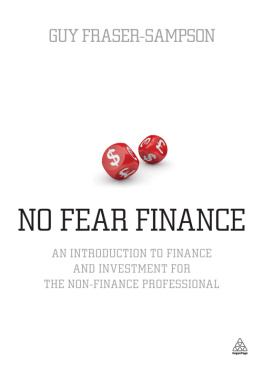
Cover design: Wiley
Copyright 2014 by Chuck Widger and Dr. Daniel Crosby. All rights reserved.
Published by John Wiley & Sons, Inc., Hoboken, New Jersey.
Published simultaneously in Canada.
No part of this publication may be reproduced, stored in a retrieval system, or transmitted in any form or by any means, electronic, mechanical, photocopying, recording, scanning, or otherwise, except as permitted under Section 107 or 108 of the 1976 United States Copyright Act, without either the prior written permission of the Publisher, or authorization through payment of the appropriate per-copy fee to the Copyright Clearance Center, Inc., 222 Rosewood Drive, Danvers, MA 01923, (978) 750-8400, fax (978) 646-8600, or on the Web at www.copyright.com. Requests to the Publisher for permission should be addressed to the Permissions Department, John Wiley & Sons, Inc., 111 River Street, Hoboken, NJ 07030, (201) 748-6011, fax (201) 748-6008, or online at http://www.wiley.com/go/permissions.
Limit of Liability/Disclaimer of Warranty: While the publisher and author have used their best efforts in preparing this book, they make no representations or warranties with respect to the accuracy or completeness of the contents of this book and specifically disclaim any implied warranties of merchantability or fitness for a particular purpose. No warranty may be created or extended by sales representatives or written sales materials. The advice and strategies contained herein may not be suitable for your situation. You should consult with a professional where appropriate. Neither the publisher nor author shall be liable for any loss of profit or any other commercial damages, including but not limited to special, incidental, consequential, or other damages.
For general information on our other products and services or for technical support, please contact our Customer Care Department within the United States at (800) 762-2974, outside the United States at (317) 572-3993 or fax (317) 572-4002.
Wiley publishes in a variety of print and electronic formats and by print-on-demand. Some material included with standard print versions of this book may not be included in e-books or in print-on-demand. If this book refers to media such as a CD or DVD that is not included in the version you purchased, you may download this material at http://booksupport.wiley.com. For more information about Wiley products, visit www.wiley.com.
Library of Congress Cataloging-in-Publication Data:
Widger, Chuck.
Personal benchmark: integrating behavioral finance and investment management/Chuck Widger and Dr. Daniel Crosby.
pages cm
Includes bibliographical references and index.
ISBN 978-1-118-96332-6 (hardcover); ISBN 978-1-118-96339-5 (ePDF); ISBN 978-1-118-96333-3 (ePub)
1. Investment advisors. 2. Investment advisor-client relationships. 3. FinancePsychological aspects. 4. Portfolio managementPsychological aspects. I. Crosby, Daniel, 1979- II. Title.
HG4621.W46 2014
332.6019dc23
2014020577
Dedication
This book is dedicated to America's advisors.
Professionals who help investors achieve their goals.
Preface
The insight that inspired this book emerged in the spring of 2010 during an otherwise typical investment advisory discussion. My client, Rick, had investment needs. Like many investors, he wanted a conservative approach (low volatility) to managing his investments. Also like many investors, he simultaneously needed growth to increase his purchasing power. An inherent conflict. Thus, Rick called me to seek guidance on how to assemble a portfolio that would best meet his goals.
But Rick wasn't just any client. Rick was my longtime friend of more than 55 years. In the eighth grade, we played soccer together. In high school, we (along with our teammates) won the 1962 Pennsylvania State Championship. June 3, 1967, we entered Navy officer candidate school in Newport, Rhode Island together.
In 1970, I left active duty to join the finance industry. Rick went on to become a career Naval officer, rising to the rank of Captain in the Naval Supply Corp and earning a master's degree in computer science at the Navy's postgraduate school in Monterey, California along the way. He also prudently saved and invested his entire adult life.
Those of us who have the benefit of lifelong friendships know how special they are, especially at Rick's and my age. We shared a significant part of our youth together. Each of us was proud to serve our country. We each appreciate the career achievements of the other. And, importantly, we tease each other over minor missteps when we were young and a few misadventures we each have experienced as adults. There is an irreplaceable comfort in high quality, mutually respectful lifelong friendships.
Today, Rick and his lovely wife Dana have two children and three grandchildren. His personal goal is to provide for Dana on his death, and for his children and grandchildren on the death of the survivor.
Thus, when he turned to me in the spring of 2010 for investment advice, I was keenly aware of the discipline and sacrifice it took for him to assemble his portfolio. And I was intimately aware of the individuals who were trusting me for advice. So, as with any client, I took my advising role with Rick very seriously.
Rick knows from personal experience that markets are volatile. He also understands that at our age if he suffers a significant loss, he may not have time to recover. Thus, like many people, he prefers a conservative approach to managing his investments. Yet, his conservative bias is in conflict with another of his investment goals. Rick knows he must increase his purchasing power over time to maintain his standard of living. To increase purchasing power, investors must stay invested over reasonably long periods of time. Therein lies the rub: Rick is an action-oriented guy. Staying invested through good times and bad is at odds with his no-nonsense mentality of, Don't just stand there, do something! when things get rough. When volatility strikes, he (like many others), wants to reduce his volatility and chances of loss, even if that means reducing the chances for growth. In short, Rick's conservative (low volatility) approach was stymying the growth component his portfolio needed.
As I thought about Rick's investment goals and risk tolerance, I intuitively saw that by establishing specific goals (low volatility, growth) for each purpose, I could confidently recommend a tested Brinker Capital investment strategy that I believed had a high probability of achieving each goal. I knew in periods of market volatility, I could point out the stability of the low volatility or safety allocation and note that, over time, the more volatile growth or accumulation allocation would compound and create more purchasing power. I now know what I had solved for Rick is the dilemma psychologists call simultaneous risk preferences.
A Strategy
With this broad investment policy in mind, two different Brinker Capital investment strategies were selected initially to implement it. Each strategy is from Brinker Capital's mutual fund asset allocation program known as Destinations. Brinker Capital has eight different investment programs, with each based on the same multi-asset class investment philosophy that seeks to reduce volatility, while maintaining the opportunity for appreciation. Rick's initial portfolio investment strategy is pictured in .
Rick's Initial Portfolio Investment Strategy
Source: Brinker Capital, Inc. For illustrative purposes only.
Next page






![Tim Richards [Tim Richards] - Investing Psychology: The Effects of Behavioral Finance on Investment Choice and Bias, + Website](/uploads/posts/book/124122/thumbs/tim-richards-tim-richards-investing-psychology.jpg)
![Daniel Crosby [Daniel Crosby] - The Laws of Wealth: Psychology and the secret to investing success](/uploads/posts/book/124058/thumbs/daniel-crosby-daniel-crosby-the-laws-of-wealth.jpg)

